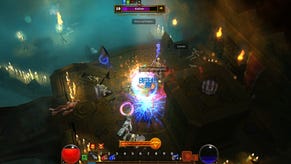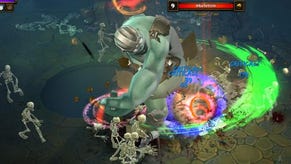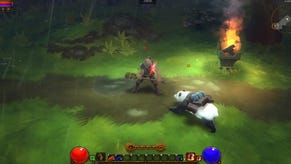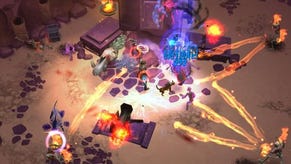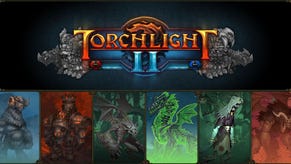Incandescent: Torchlight II Hands-On
Overground, Underground
Torchlight II fell into our hands at E3 2011. This is what happened.
We've been looking for the bandit camp for ten minutes. 'We' being me, a berserker, producer Brock as a cannon-equipped Outlander, Brock's wolf, Doggy, and my ferret, Marmot. "It's north!" cries, Marsh Lefler, VP of Runic Games. We head north. We kill massed enemies, skeletons, great halberd-wielding beastthings, endless wolf-like things. Almost every thing we kill drops loot and before long we're laden like junk pedlars. Our pets run back to town with the vendor junk and return laden with gold.
We hit a dead end. "It's south..." groans Marsh. We head back south, make more monster-babies orphans on the way. We head east. West. We cross hills, burn smaller bandit villages, pass dungeon mouths, traverse rivers. There's still more to explore. We get separated for five minutes, one of us heads into a dungeon, the other rescues a merchant from brigands, eventually we find the bandit camp. All the time we're moving, there's nothing but death; my recording at this point descends into the sounds of clicking, cartoon grunting and my occasional insane giggle.

Night is falling in the game, as we torch the thatch of the bandit cottages and descend to confront the bandit leader. He's hiding out in a prison, a classic Torchlight enemy – in classic Warcraft style, his size indicates his threat and he's great hulk of a man who hurls barrels at us. We kill him, eventually, and take his gold, then emerge back into the massive overworld.
Torchlight II is huge.
The size isn’t the biggest change; that would be the addition of overworld to the underworld. The first Torchlight had you going down and down and down from the main town, through increasingly nasty randomly generated levels, as well as visiting secondary dungeons through scrolls. This version has overland areas as its main arena, with dungeon mouths scattered throughout them. We're playing through one of the two overland areas in the first of the game's four acts (only one of which isn't set outside) and it's mentally large. Even Brock at one point says, worried, “I think you made this level too big. It's seriously big. There's a lot of South.”

There's a huge variety of terrain and associated abominations across it; though not much in the way of welcoming people, save for quest givers. Moreover, the key locations, like everything else are randomly located. Like Frozen Synapse’s singleplayer, the developer merely specifies how many of each element should appear on the mapThis is why it took us 30 minutes to find the first objective, the bandit slavers' camp – because even the developers couldn’t know where it was.
As we’re starting the Bandit quest, we find one of the random dungeons. These are the thing that's changed least from Torchlight; they're crammed with colourful design that passes in a flash as you crush a huge variety of enemies for loot. We're given a quest to get inside, releasing spirits from their tombs (by smashing them) to open the gate. "One thing try we're trying to do” says Marsh “is make it more interactive; you don't just go to town and get a quest to kill five warbeasts, you'll go out into the wilderness and find a caravan being attacked by zombies and, if you kill them before they kill him, you'll get the reward."

This one is full of skeletons of all types, who we batter into pieces, with the more fragile Brock only dying once or twice. At the end is the usual massive boss; an ogrelike abomination who endlessly spawns more skeletons from the pit he crawled out of, and who vomits aggressive maggots over you. The fight’s over quickly, mainly because they’ve given our characters over-powered gear, but there are tons more enemies to come. “The first act alone has more bosses than the whole of Torchlight” says Marsh. Upon killing the boss, he drops a bunch of good player-specific loot - not out of luck, but because in co-op you can only see your own loot.
The second big thing is the drop-in, drop-out co-op, which is so sexy right now. It suits Torchlight II down to the ground though. The game keeps track of all the quests your characters have done together, as well as allowing you to level up whilst playing. It's also a good opportunity to try out another character class, which was a problem with the first game - like many RPGs, there was no way of trying before buying, meaning most players had no idea what it was like to play the other classes. Marsh admits that “it’s a hard one to solve”; Perhaps the return of the retirement system will encourage players to try out alternate classes.

Speaking of which, there are going to be four character types in Torchlight II: the Railman, who wields great two-handed gavels, pin-hammers and the like; The Outlander, who's rather acrobatic so fills in a hit and run role. And the Berserker who's both tank and damage dealer. The fourth is, in one of those classic PR moves to build buzz, yet to be revealed.
It's worth emphasising that nothing has changed about the wonderful pet system. Torchlight inherited from Fate. You pick your pet at the start of your career, and they act as a weakish henchman. More importantly though, they still have their separate inventory and can still be sent back to town to auto-sell everything it's carrying. Finally, fishing is going to make a reappearance; fish can either be sold or fed to your pet, morphing it for a limited time into a monster (which one depends which fish you get).

Finally, there should be a proper plot this time; "we hired a writer, so we have a story to tell.” We think this slaver attack might be part of that plot - but it’s definitely hard to tell what is and what isn’t, as the plot is rather sketchy at the moment; it involves a return to Estheria and how the conclusion of the previous game affected the characters in it, but we don’t have more details than that.
Torchlight II is looking solid. That said, while the co-op and overland both add to the game, they do sadly moving it closer to a more generic action-RPG like Dungeon Siege 3. We can hope it can maintain its identity and its quirkiness, and come up with other unique systems like pets or retirement to stave off a more generic fate.

